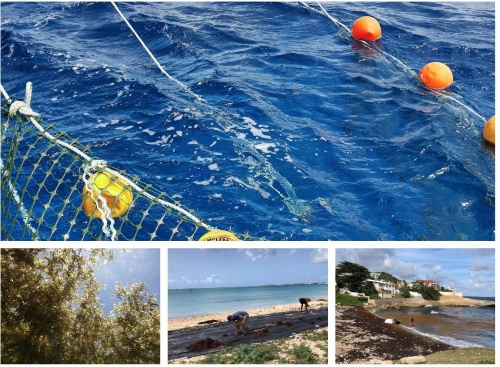 PHILIPSBURG:--- The Climate Cleanup Foundation visited St. Maarten to study sargassum landings, collect sargassum, perform tests and take samples, in order to find solutions for the sargassum invasions by researching several options of using the sargassum and possibly creating carbon sinks. Two members of the Climate Cleanup Team visited Sint Maarten in September to conduct research on the Sargassum Seaweed, the team got intrigued by the problems the algae cause for us humans and our ecosystems. In September Peter Lindeman and Fons Janssen working for Climate Cleanup, a Dutch NGO (see www.ClimateCleanup.org), held their trip for field research. They needed to obtain samples of the Sargassum plague they are studying. Peter: “This expedition has made us even more determined to find solutions for the excessive growth of Sargassum in the region.”
PHILIPSBURG:--- The Climate Cleanup Foundation visited St. Maarten to study sargassum landings, collect sargassum, perform tests and take samples, in order to find solutions for the sargassum invasions by researching several options of using the sargassum and possibly creating carbon sinks. Two members of the Climate Cleanup Team visited Sint Maarten in September to conduct research on the Sargassum Seaweed, the team got intrigued by the problems the algae cause for us humans and our ecosystems. In September Peter Lindeman and Fons Janssen working for Climate Cleanup, a Dutch NGO (see www.ClimateCleanup.org), held their trip for field research. They needed to obtain samples of the Sargassum plague they are studying. Peter: “This expedition has made us even more determined to find solutions for the excessive growth of Sargassum in the region.”
Climate Cleanup is an NGO working on natural climate solutions. Fons: “Our goal is to bio-sequester 1500 gigaton of CO2, to work with nature to reverse climate change. Sargassum seaweed is sequestering lots of CO2, but when beaching it smothers coastal areas, kills natural ecosystems such as mangroves and seagrass, and causes health and economic problems to people. We are trying to find ways to make the best use of the seaweed, while also preventing it from washing ashore. Therefore, we are working on the valorization of the seaweed, as well as capturing and storing it as a natural carbon sink.”
For two weeks Fons and Peter have been harvesting and drying 1500 kilograms of Sargassum Seaweed. The team of Nature Foundation Sint Maarten offered lots of help, from providing transportation, boat, and crew for catching Sargassum at sea, to arranging land space and support from many local people and organizations. Peter: “We got such a great welcome on this beautiful island, meeting great people and learned so much from all the conversations. We took many samples which we have taken home and which will be tested in several labs. We are diving deep into different types of use of Sargassum, think about biogas, paper, building blocks and composting. We are also researching into sinking the seaweed to the deep-sea, mimicking the natural life cycle of the seaweed when floating in the Sargasso Sea. To save our planet we need to take a lot of CO2 out of the atmosphere to fight climate change, something seaweed can do perfectly. Thus, we are taking problems such as Sargassum and aim to turn it around into a solution; one which is beneficial to people and nature.”
The Nature Foundation has often been forewarning the public about the increased amounts of Sargassum Seaweed on the Eastern beaches of St. Maarten, typically starting in late spring each year. In the summer months the temperature increases which causes the sargassum to bloom, this seaweed has been an increasing problem throughout the Caribbean since 2011 landing on beaches in massive amounts and decomposing slowly. Sargassum is a genus of brown (class Phaeophyceae) seaweed which is distributed throughout the temperate and tropical oceans of the world.
Along with causing a build-up of seaweed on the beaches, the decomposing sargassum can cause potential health problems by emitting a colorless, toxic and highly flammable gas called hydrogen sulfide. This gas spreads an unpleasant odor much like the smell of rotten eggs. The Nature Foundation is excited about this research from the Climate Cleanup Foundation and is looking forward to hearing about positive results and possibilities!












